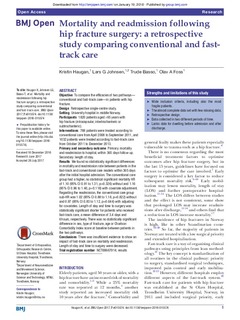| dc.contributor.author | Haugan, Kristin | |
| dc.contributor.author | Johnsen, Lars Gunnar | |
| dc.contributor.author | Basso, Trude | |
| dc.contributor.author | Foss, Olav A. | |
| dc.date.accessioned | 2018-02-09T13:23:37Z | |
| dc.date.available | 2018-02-09T13:23:37Z | |
| dc.date.created | 2018-01-18T17:12:39Z | |
| dc.date.issued | 2017 | |
| dc.identifier.citation | BMJ Open. 2017, 7:e015574 . | nb_NO |
| dc.identifier.issn | 2044-6055 | |
| dc.identifier.uri | http://hdl.handle.net/11250/2483758 | |
| dc.description.abstract | Objective To compare the efficacies of two pathways—conventional and fast-track care—in patients with hip fracture.
Design Retrospective single-centre study.
Setting University hospital in middle Norway.
Participants 1820 patients aged ≥65 years with hip fracture (intracapsular, intertrochanteric or subtrochanteric).
Interventions 788 patients were treated according to conventional care from April 2008 to September 2011, and 1032 patients were treated according to fast-track care from October 2011 to December 2013.
Primary and secondary outcome Primary: mortality and readmission to hospital, within 365 days follow-up. Secondary: length of stay.
Results We found no statistically significant differences in mortality and readmission rate between patients in the fast-track and conventional care models within 365 days after the initial hospital admission. The conventional care group had a higher, no statistical significant mortality HR of 1.10 (95% CI 0.91 to 1.31, p=0.326) without and 1.16 (95% CI 0.96 to 1.40, p=0.118) with covariate adjustment. Regarding the readmission, the conventional care group sub-HR was 1.02 (95% CI 0.88 to 1.18, p=0.822) without and 0.97 (95% CI 0.83 to 1.12, p=0.644) with adjusting for covariates. Length of stay and time to surgery was statistically significant shorter for patients who received fast-track care, a mean difference of 3.4 days and 6 hours, respectively. There was no statistically significant difference in sex, type of fracture, age or Charlson Comorbidity Index score at baseline between patients in the two pathways.
Conclusions There was insufficient evidence to show an impact of fast-track care on mortality and readmission. Length of stay and time to surgery were decreased. | nb_NO |
| dc.language.iso | eng | nb_NO |
| dc.publisher | BMJ Publishing Group | nb_NO |
| dc.rights | Navngivelse-Ikkekommersiell 4.0 Internasjonal | * |
| dc.rights.uri | http://creativecommons.org/licenses/by-nc/4.0/deed.no | * |
| dc.title | Mortality and readmission following hip fracture surgery: A retrospective study comparing conventional and fast-track care | nb_NO |
| dc.type | Journal article | nb_NO |
| dc.type | Peer reviewed | nb_NO |
| dc.description.version | publishedVersion | nb_NO |
| dc.source.pagenumber | 8 | nb_NO |
| dc.source.journal | BMJ Open | nb_NO |
| dc.identifier.doi | 10.1136/bmjopen-2016-015574 | |
| dc.identifier.cristin | 1546708 | |
| dc.description.localcode | © Article author(s) (or their employer(s) unless otherwise stated in the text of the article) 2017. All rights reserved. No commercial use is permitted unless otherwise expressly granted. This is an Open Access article distributed in accordance with the Creative Commons Attribution Non Commercial (CC BY-NC 4.0) license, which permits others to distribute, remix, adapt, build upon this work non-commercially, and license their derivative works on different terms, provided the original work is properly cited and the use is non-commercial. See: http://creativecommons.org/licenses/by-nc/4.0/ | nb_NO |
| cristin.unitcode | 194,65,30,0 | |
| cristin.unitname | Institutt for nevromedisin og bevegelsesvitenskap | |
| cristin.ispublished | true | |
| cristin.fulltext | original | |
| cristin.qualitycode | 1 | |

